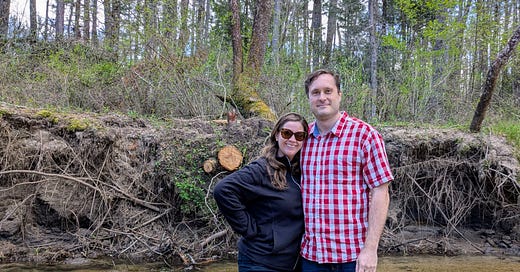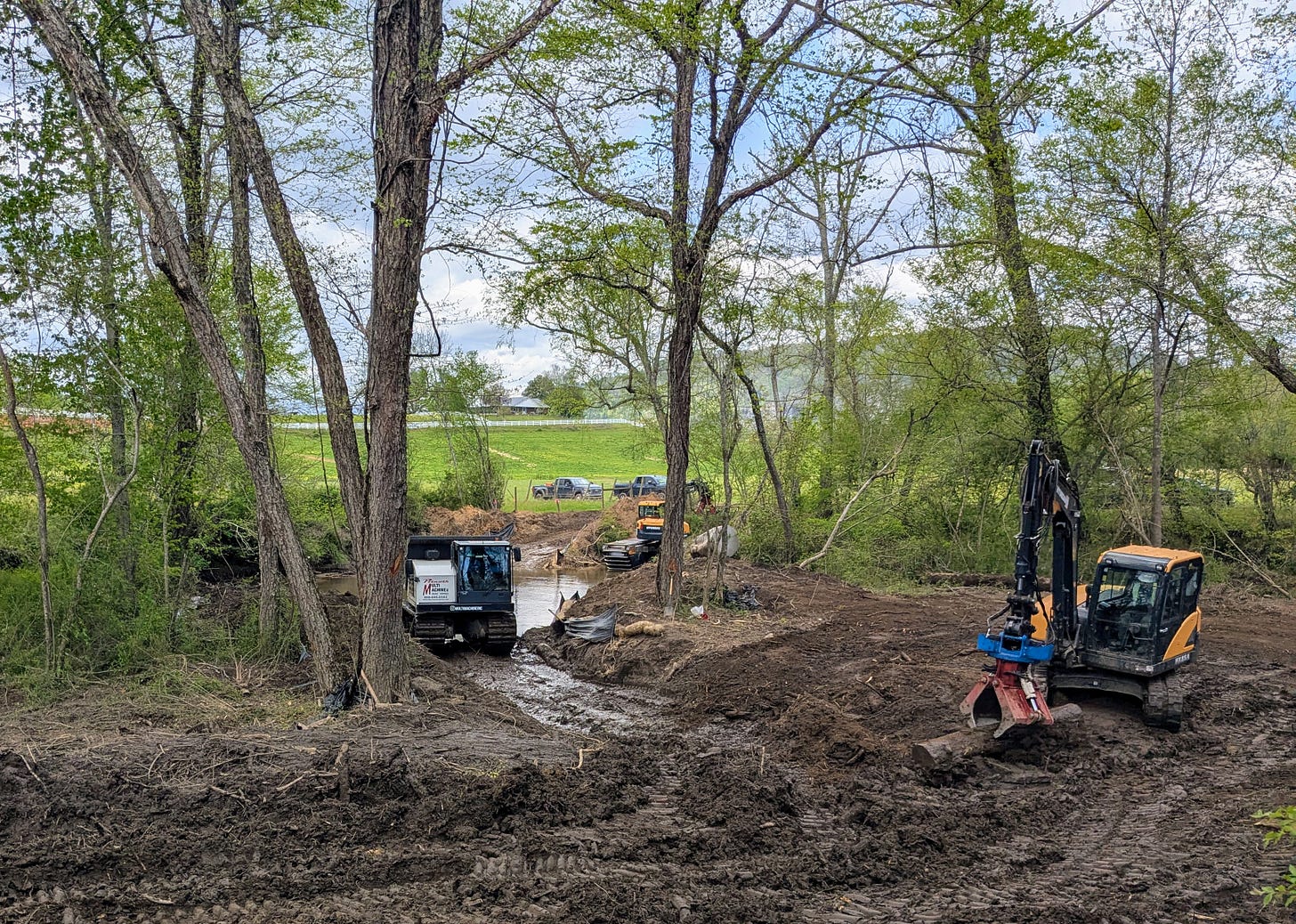Excess Debris Removal in County Rivers Created “Ecological Crisis,” Critics Say, and Could Cost as much as $66 Million
The clearance of rivers choked with deadfall from Helene is needed to protect bridges and prevent future flooding. But critics decry its bloated costs and habitat destruction.

CEDAR MOUNTAIN – Lauren Wilkie saw no need for debris removal at her property on the Little River near Greenville Highway.
By the start of April, she and her husband, Don, had long ago removed the limbs deposited by the epic flooding of last year’s Tropical Storm Helene.
The vine-draped trees arching over the river held firm during the storm and held the bank in place. The shelf of boulders placed in the stream decades ago was still doing what it had done for as long as Wilkie could remember, she said, creating a pool so inviting to trout that “we could do catch-and-release fishing” a few steps from the back door of the house her grandfather helped build in 1972.
But on April 9, a federal contractor cut down the trees, scattered the stones, and hauled away every fallen limb no matter how firmly lodged in the bank, she said. For several more days, a steel-tracked truck carried loads of debris up and down the river, crushing rocks, churning up sediment and reducing the bank opposite Wilkie’s home to a wall of dirt and exposed roots.
Neither she nor her husband asked for work to be done on their property, she said, and they didn’t see the damage until they woke up to a shockingly transformed river on the morning of April 10.
“There’s no fish. There’s no wildlife in the river,” she said last week while sitting on her bankside patio. “It’s just been devastated.”
In recent weeks the US Army Corps of Engineers and its debris removal contractors have responded to complaints from residents like Wilkie, who at one point waded into the river to stop heavy equipment from passing.
Representatives from the Texas company that did the damage to her land have pledged to try to undo it, she said. And a Corps spokesman said the agency met with an array of government groups in mid April to better coordinate waterway clearances.
This work is part of a larger effort to remove Helene’s debris from land and rivers in storm-ravaged North Carolina counties that as of last Friday had cost $1.44 billion, the spokesman said.
He also said the clearance of just the waterways in Transylvania County, where work started in March and is expected to continue through May, could cost as much as $66 million – or about $28 million more than the estimated price of the county’s planned new courthouse.
Local governments, including Transylvania, requested the debris removal, some of which, even its harshest critics say, was needed to clear logjams that worsen future flooding and endanger bridges and other vulnerable infrastructure.
But those critics also pointed to research showing the kind of blanket removal of debris being conducted does little to prevent future flooding, while leading to bloated costs and what the Conserving Carolina nonprofit calls an “ecological crisis.”
Crews dug up large, submerged trees that armored banks and needlessly cleared live growth that both prevented erosion and filtered the runoff that is the primary source of pollution in the Little and French Broad rivers.
Heavy equipment crushed mussel beds, including those of federally endangered elktoes. Formerly teeming stretches of the rivers have been left at least temporarily devoid of trout, darters and state-endangered hellbender salamanders.
“Time will tell,” said Owen Carson, an ecologist and chair of the Transylvania Natural Resources Council, “but I’m pretty sure this is going to end up being extremely detrimental to river habitats.”
Limited Role for State and County
These environmentalists, as well as local and state officials, said primary responsibility for the work falls on the Corps.
In some stretches of the Little and French Broad, the work appears to clearly violate longstanding North Carolina Wildlife Resources Commission recommendations for removing storm debris.
These “best management practices” have been distilled to a one-page “fact sheet” requesting contractors “minimize use of heavy equipment in streambeds,” focus on removing only limbs and tree trunks “carried by flood waters,” and avoid removing wood embedded in banks or cutting down live trees and shrubs unless they are “in immediate danger of falling” or leaning more than 45 degrees over channels.
The sheet also provides “Special Guidance” for work in stretches of river classified by the Commission as “high quality habitat” due to the presence of sensitive species.
In these areas, which cover much of the Little and French Broad in Transylvania, crews should take “extreme care” when working on the banks, avoid streambeds “as much as possible,” and notify the Commission before work begins to arrange for the protection of vulnerable wildlife.
The Commission is not a regulatory agency and the best management practices are recommendations, Shannon Deaton, the Commission’s habitat conservation division chief, wrote in an email, and she acknowledged the Commission did not produce its one-page fact sheet or provide contractors with maps of high quality habitat until early April.
But she also wrote that the Corps didn’t reach out: “NCWRC was not contacted before the recent work at some sites in Transylvania County, such as the Little River.”
Several Western North Carolina counties hired contractors and are supervising their work, she also wrote, but Transylvania is not one of them, County Manager Jamie Laughter said at Monday’s County Commission meeting.
The county has no “influence” over the contractors’ work, she said, has not received promised updates from the Corps about its progress and has no say in determining whether crews can access stretches of river flowing through private property.
“We have absolutely no way of being involved in those activities at all,” she said.
Money Grab?
The county also ended up having little role in determining where the contractors would work, she said.
Bobby Petty, a Corps public affairs officer, wrote in an email that local governments “identify the (removal) sites immediately after a disaster.”
But Laughter said that after the county provided the Corps and Federal Emergency Management Agency with a list of 14 potential spots for clearance, it was told the agencies would “instead” make such assessments using drones. A total of 40 “eligible sites” were identified, 22 of which have now been cleared, according to a document Petty provided.
The amount of debris to be removed has also grown from the original (and very approximate) estimate of 5,000 cubic yards to 82,000 cubic yards, he wrote, about 57,000 of which have cleared so far.
Once Corps contractors access the rivers, they are allowed to move upstream and downstream because the agency has “jurisdictional authority over these waterways for purposes such as navigation, flood risk management, and public safety.”
To provide context for the extensive clearance work, Petty wrote that Helene was a historically massive event and “many public officials have noted that in terms of complexity, the debris removal is on par to that of Hurricane Katrina in 2005.”
Besides reducing the impact of future storms, he wrote, the work can prevent bank erosion, clear natural fire breaks and support recreation and tourism.
Though contractors are paid for each cubic yard removed, he also wrote, the Corps provides extensive training and supervision to ensure responsible removal and avoid excess.
“Contractors know they will be penalized: they won’t be compensated, and/or could have their current contract cancelled if they take more trees than they’re authorized to remove,” Petty wrote. “Over-clearing is not tolerated.”
But it was, at least in Mitchell County, said Nathan Turpin, a heavy equipment operator who lives in that county and briefly worked there for a federal debris-removal contractor.
The initial training that emphasized selective clearance was mostly ignored once the work began, he said, and the Corps’ inspections were occasional and cursory.
His crew’s hard-driving supervisor applied constant pressure to remove as much debris as possible to cash in on the per-cubic yard payments, said Turpin, who resigned because of the job’s unpleasant atmosphere and destructive results.
“There was a certain quota of, you know, how many loads of debris we had to get out in the day to make a profit,” he said. “We’re taking anything and everything because nobody's looking and nobody's regulating this . . . It was a money grab.”
The “Absolutist” Approach
The results of such indiscriminate clearing can be seen on a stretch of the Little designated as high-quality habitat near Cascade Lake Road, said Hans Lohmeyer, stewardship coordinator for Conserving Carolina.
Standing on the side of the road last Friday, he pointed to the 18-inch-wide stump of a once-healthy tree that had been removed despite being rooted several feet above the channel.
A contractor’s access point on the opposite bank was a bare pile of mud, primed to be washed away in the next flood.
When he snorkeled this stretch of the river soon after the work’s completion, he saw neither trout nor the endangered hellbenders that had previously been documented in the river.
He did see boulders reduced to rubble, the crushed shells of elktoes, and, he said, “individual mussels laying on their sides, gaping, which is a sign of stress.”
The damage will likely be lasting, he said, because of the crucial roles that rocks, trees and woody debris play in supporting healthy mountain streams.
“All these sensitive species, freshwater mussels, hellbenders, trout – they can’t handle warming water,” he said. “They are dependent on cool rivers and streams.”
That means they need the shade provided by riverside trees and large rocks, the undersides of which are the favored summer refuges of hellbenders and other large and long-lived salamanders.
Trout lay their eggs in rocky river bottoms, as do mayflies and other insects that a host of fish and amphibian species depend upon for food.
Both living trees and embedded deadfalls stabilize banks, he said, while submerged logs also create pools for resting trout and, downstream from these pools, riffles flowing over cobbled streambeds where trout and darters feed.
Wholesale clearance, on the other hand, creates narrow channels of unimpeded flow that are inhospitable to the filter-feeding mussels that stabilize riverbeds and purify water.
These “flumes” add to the threat of catastrophic riverbank collapse and ongoing erosion, creating sediment loads that bury healthy streambeds and constitute the most consistent pollution threat to mountain streams.
The contractor on the devastated stretch of the Little apparently had “one goal, and I would describe it as absolutist,” Lohmeyer said, “to clean up woody debris and storm debris and do it as efficiently as possible . . . to the point of the loss of ecological integrity.”
Return on Investment
Beyond the environmental impacts are the financial concerns.
Returning this stretch to its former state, Lohmeyer said, will likely require expensive stream restoration, which typically does exactly the opposite of the work done by the worst of the removal operations.
Last year, for example, a contractor hired by the city of Brevard restored a short stretch of Norton creek by grading banks into gradual slopes. Crews spread smooth cobbles on the stream’s bed and planted trees on its banks. They arranged for the diversion of floodwaters onto a grassy plain where it can be harmlessly confined and purified.
Originally budgeted for $190,000, the project ended up costing the city about $450,000.
Lohmeyer also pointed to research that raised the likelihood that at least some of the debris removal won’t do the job touted as justifying its costs – limiting the impact of future flooding.
A report published recently by researchers at North Carolina State University said “actual flood reduction” attributed to stream clearance has “varied widely and (is) often anecdotal in nature.”
The study quantified these impacts by running computer models replicating the effects of removing “LW” (large wood). Though the benefits varied depending on topography, this work was shown to reduce flood levels by an average of only about a foot, the study found.
That doesn’t mean that all stream clearances should cease, the report said, but “overall, we recommend moving away from blanket removal of LW and toward limited strategic removal that will result in the desired outcomes.”
Finding the Balance
It can be a tough balance to achieve, Lohmeyer said, and “some contractors did a better job than others.”
For example, work on the French Broad in and around Rosman has been highly beneficial, said David Whitmire, the longtime owner of Headwaters Outfitters and, like Carson, a member of the Natural Resources Council.
Because of the cumulative effects of Helene, 2021’s Tropical Storm Fred and the massive die-off of riverside hemlock trees caused by infestations of woolly adelgids, “the amount of debris we were seeing in the river was just way more than I’ve ever seen,” said Whitmire, a Transylvania native.
That included large piles of wood behind the bridge at Champion Park in Rosman, said Whitmire, who added that such accumulations don’t just worsen flooding but add to the harm it does, pointing to the Helene-propelled tree trunks and limbs that took down fences around Rosman High School’s athletic fields and the town’s wastewater treatment plant.
The NC State study shows that debris removal works best to prevent floods in rivers with narrow channels flanked by limited floodplain.
And that perfectly describes the stretch of the French Broad immediately downstream from Whitmire’s business at the confluence of the river’s north and west forks, he said.
The channel is “very narrow, so the faster we get that water downstream and away from us, the better,” he said. “Rosman literally is the floodplain.”
But leaving some deadfall helps divert water into the open land downstream from the town, Carson said, and the vast debris removal he saw on that stretch of the French Broad on an Easter paddling trip will limit the floodplain’s role in holding and absorbing stormwater, while encouraging potentially destructive high-speed flows.
“I was able to witness tons and tons of trees of all diameters that had been cut, that were upright, that had been alive,” he said. “Vegetation had been ripped off of banks. There were places where root balls had been removed.”
Petty cautioned against reading too much into anecdotal reports of diminished aquatic life. Though the impacts of Helene might not be known for years, it’s likely that some animals “migrated’ to escape the flooding and established new populations downstream.
“There’s hope in the axiom ‘life finds a way,’ ” he wrote.
Maybe so, said Kevin Merrill, who owns the Oxbow River Snorkeling guide service and has a masters degree in freshwater biology, and who added that the disruption from the clearance work might also prove to be temporary.
Still, he was struck by the near total absence of visible life when he snorkeled the same stretch of the French Broad that Carson paddled, and on the same afternoon.
Deadfall provides habitat for, among other species, perchlike tangerine darters, he said, and when he checked on one of their favorite hangouts, where he “always” finds these fish, he said, “I didn’t see any.”
One Landowner’s Story
Margie Huggins witnessed both responsible and irresponsible work on the stretch of the Little that runs through her 16 acres on Hart Road.
Her parents bought the land in 1976, she said, and when she moved there after their deaths in 2022, she set about returning it to its natural state, installing nesting boxes for flying squirrels and wood ducks, hiring landscapers to remove invasive privets and multiflora roses.
So she was delighted when, soon after moving to the property, biologists from the state Wildlife Commission found protected species in her stretch of the river, which is designated by the agency as high-quality habitat.
In early April, when she told debris-removal workers upstream from her land that she didn’t want them to pass her property line, they said they had no plans to do so.
“I assume they knew it had hellbenders and mudpuppies in it,” said Huggins, a retired lawyer.
But a short time later, she found a heavy equipment operator working in the downstream side of the river about 100 yards inside her property line.
“He had his little bucket pincher in there,” she said, and had dug up a “big old log – it looked almost like prehistoric wood – off the bottom of the river bank.”
“He said, ‘Do you want me to put it down?’ I said, ‘Yes I do,’ ” she said. “I told him, ‘You’re supposed to be picking up stuff from Helene and that’s no more from Helene than fly to the moon.’ ”
Email: brevardnewsbeat@gmail.com







Curious about other counties that hired people to supervise this river cleanup, and why Transylvania County failed to do so? Was this ever discussed at a Council meeting? If not Maybe its time we vote out the dinosaurs who have served more than 2 terms.
This one's pretty simple. You keep voting for rapacious looters and sooner or later and eventually repeatedly you get looted.